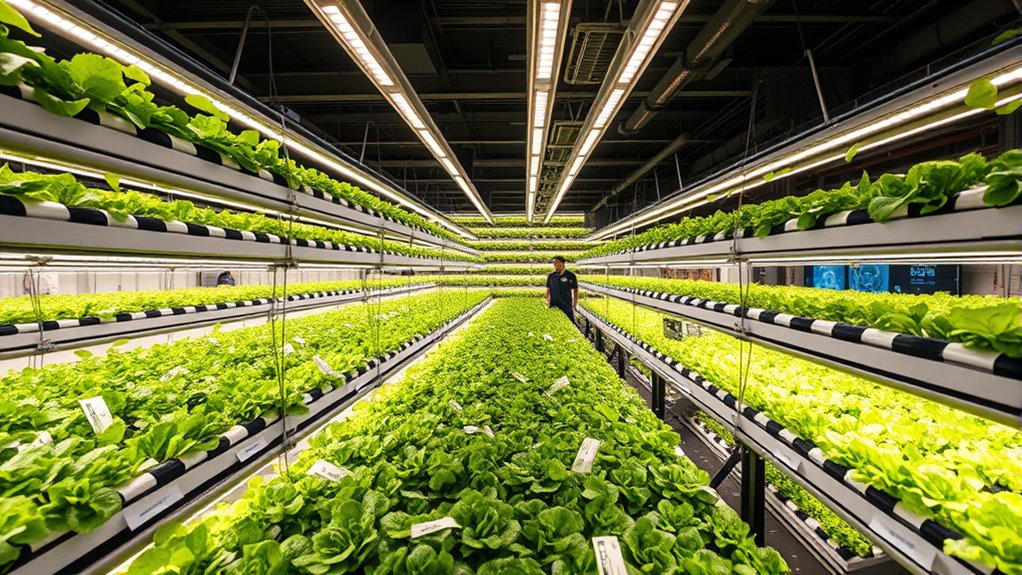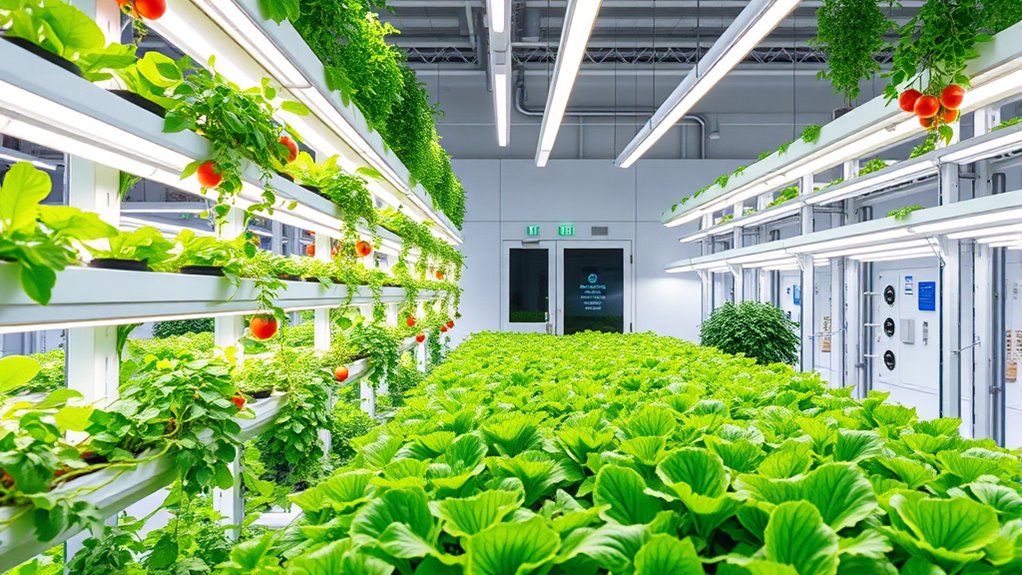Worldwide, governments are actively supporting vertical farms through policies that boost urban agriculture, promote food sovereignty, and improve food security. They offer incentives like funding, regulations, and training to help communities develop local food sources and reduce dependency on distant supply chains. These policies also address food deserts and create economic opportunities while emphasizing sustainability and resource efficiency. Continuing to explore these strategies reveals how they are shaping resilient, autonomous urban food systems to meet future challenges.
Key Takeaways
- Governments worldwide implement policies supporting urban agriculture and vertical farming to enhance local food production and sovereignty.
- Incentive programs, including funding and regulatory frameworks, promote vertical farm adoption in cities globally.
- Policies address food deserts by integrating vertical farms into urban planning, improving access to fresh, nutritious produce.
- Education and sustainability initiatives in policies help optimize resource use and foster community empowerment in vertical farming.
- International collaboration and innovation policies drive technological advancements, reducing transportation emissions and strengthening food resilience.

Have you ever wondered how governments guarantee that everyone has reliable access to enough nutritious food? One key strategy involves supporting urban agriculture initiatives, which bring food production directly into city environments. These programs empower communities to grow their own fruits and vegetables, reducing dependence on distant supply chains. By integrating urban agriculture into national food security policies, governments promote food sovereignty—the right of people to control their food systems and make decisions about local food production. This shift helps guarantee that communities are less vulnerable to disruptions like climate change, trade conflicts, or economic crises that can threaten traditional food supplies.
Supporting urban agriculture enhances food sovereignty and resilience against disruptions in traditional food supply chains.
Vertical farms play an essential role in these efforts. They are a form of urban agriculture that use stacked layers in controlled environments, often within skyscrapers or repurposed buildings. Governments around the world are recognizing their potential because vertical farms can produce large quantities of fresh food year-round, regardless of outdoor weather conditions. By adopting policies that incentivize vertical farming, countries are making strides toward self-sufficiency. These policies often include financial support, research funding, and regulatory frameworks that encourage innovation and investment in vertical farm technology. The goal is to create resilient food systems within urban areas, reducing the need for long-distance transportation and lowering carbon footprints.
In many regions, policymakers see vertical farms as a way to address food deserts—areas where fresh produce is scarce or unaffordable. Supporting urban agriculture through legislation and funding enables communities to develop local food sources and regain control over their food supply chains. This empowerment aligns with the broader concept of food sovereignty, which emphasizes local decision-making and sustainable practices. Governments are increasingly incorporating vertical farms into urban planning, recognizing their potential to boost food security while also creating job opportunities and fostering community engagement.
Moreover, these policies often include education and training programs to help residents and entrepreneurs develop skills necessary for vertical farming. They also promote sustainable practices like water recycling and renewable energy use, ensuring that urban agriculture contributes to environmental health. Additionally, understanding cost variances, such as production quantity variance, can help optimize resource allocation and improve the efficiency of vertical farming operations. As these policies evolve, they not only strengthen food security but also promote social equity, giving more people access to fresh, nutritious food. Ultimately, supporting vertical farms within extensive food security policies helps create a more resilient and autonomous food system, empowering communities to thrive regardless of external challenges.
Frequently Asked Questions
How Do Vertical Farms Impact Local Ecosystems?
Vertical farms can positively impact your local ecosystems by reducing the strain on natural resources, helping preserve soil, and supporting urban biodiversity. Since they are built vertically, they require less land and minimize habitat disruption, allowing native plants and animals to thrive. You might notice healthier soil and increased local biodiversity, as these farms often use innovative methods that lower pollution and conserve environmental balance, benefiting your community’s ecosystem overall.
What Are the Main Technological Challenges Faced by Vertical Farms?
Think of vertical farms as high-tech gardens fighting to stay balanced. Your main challenges include optimizing hydroponic systems to reduce water use and energy, and ensuring LED lighting mimics natural sunlight effectively. For example, some farms struggle with inconsistent crop growth due to light spectrum issues. Overcoming these hurdles requires innovative solutions, like smarter sensors and energy-efficient LEDs, to keep vertical farms productive and sustainable.
How Do Policies Vary Between Countries Supporting Vertical Farming?
You’ll find that policies supporting vertical farming differ greatly across countries. Some focus on urban planning, creating designated zones and incentives for vertical farms, while others impose import tariffs on traditional produce to encourage local, sustainable options. These policies aim to boost innovation and food security, but varying regulations and incentives can either accelerate or hinder vertical farm development depending on the country’s priorities and infrastructure.
What Is the Cost Comparison Between Traditional and Vertical Farming?
You should consider the cost analysis when comparing traditional and vertical farming. Vertical farms often require higher initial investments due to advanced technology and infrastructure, making them more expensive upfront. However, they tend to have lower operating costs over time, especially with optimized resource use. Ultimately, evaluating economic feasibility depends on factors like location, scale, and long-term productivity, which can make vertical farming a cost-effective alternative despite higher initial costs.
How Do Vertical Farms Contribute to Reducing Food Waste?
Vertical farms help reduce food waste by improving urban resilience and crop diversity. You benefit from fresher produce, which lasts longer and minimizes spoilage. These farms grow a variety of crops in controlled environments, guaranteeing consistent yields and reducing overproduction. By localizing food production, you cut transportation and storage waste, making food systems more efficient. This approach supports sustainability and ensures you have reliable access to diverse, nutritious foods.
Conclusion
As you embrace the future of food, remember that vertical farms are your modern-day Noah’s Ark, safeguarding crops in a changing climate. With innovative policies fueling their growth, you’re part of a movement that’s transforming urban landscapes and ensuring food security. Keep in mind, just like the advent of the printing press revolutionized knowledge, these policies can revolutionize how you grow and access food. Together, you’re building a resilient, sustainable food system for generations to come.









